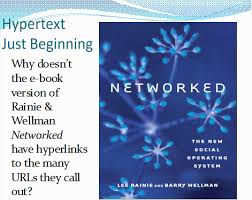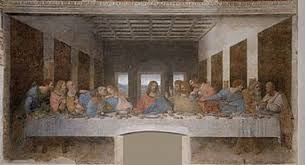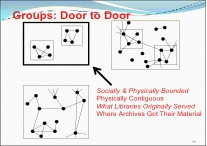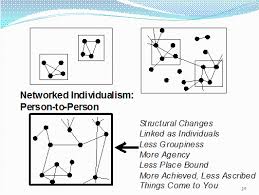Digitizing Ozymandias
For 40 years, computer scientists and sociologists have mostly danced
unaware of each other. Kelly and Alan’s book was a pioneering conversation
starter for computer scientists taking into account the social forces
driving computing and the social implications of what computerization has
wrought. Both authors have wonderfully kept the conversation going, and
they have been joined by sociologists studying the impacts of technology
on the structure of society and our everyday lives.
Digitizing Ozymandias
The dialectic between the virtual and the material is not new. Recall Percy Bysshe Shelley’s 1819 poem Ozymandias describing the statue of a fictional great warrior, where only the legs and the pedestal remain. Here’s the poem:
I met a traveller from an antique land
Who said: Two vast and trunkless legs of stone
Stand in the desert. Near them, on the sand,
Half sunk, a shattered visage lies, whose frown,
And wrinkled lip, and sneer of cold command,
Tell that its sculptor well those passions read
Which yet survive, stamped on these lifeless things,
The hand that mocked them and the heart that fed:
And on the pedestal these words appear:
“My name is Ozymandias, king of kings:
Look on my works, ye Mighty, and despair!”
Nothing beside remains. Round the decay
Of that colossal wreck, boundless and bare
The lone and level sands stretch far away.
And of course, someone has constructed a physical replica of the non-existent statue that has been virtually portrayed in the poem.

Nor is Ozymandias a singular case. The next time you go to Verona, I guarantee you’ll see a crowd gathered at the base of “Juliet’s balcony”. Indeed, you can rent the balcony for your wedding ceremony. But, of course, Juliet (and Romeo) existed only in the world of Shakespeare’s 16th century play. If they had lived today, they would have used mobile phones to stay alive. Their reliance on mobile phones would have removed them from the surveillance of their parents. “But their parents would have seen the bill at the end of the month,” one of my students protested. “Not if they texted,” another student from the Middle East answered knowingly.
So the interplay between the digital and the material – between atoms and bits – continues and develops. Yet, these are not separate worlds: there is no “digital dualism”, to use Nathan Jurgenson’s nice term (2012). Rather, we and our physical objects are part of the same worlds, although we need to think carefully about how we take care of and link our bodies, minds, and artifacts.
On November 13, 2012, Whitney Erin Boesel tweeted and emailed about a debate in her University of California Santa Cruz graduate course. Sociology professor Jenny Reardon asked her class, “What about albums: Do people still listen to albums.” Boesel reported: “This caused some confusions; what does she mean by ‘album?’ Do digital files count? I interjected to define an album as ‘a set of tracks that an artist records and releases together, as a set and in a specific order, that you listen to in that order.’” Prof. Reardon responded, “See, an album is no longer a ‘thing’; it’s become a concept!” The material album has become a virtual concept.
 Yet, I am writing this essay while listening to the sound of the Rolling Stones’ greatest hits—on a vinyl LP of course. Next to me, the face of Keith Richards stares from the material cover of his majestic autobiography (2010), part of whose joy is its hefty 565 pages. This is an experience that cannot be fully reproduced in an e-book.
Yet, I am writing this essay while listening to the sound of the Rolling Stones’ greatest hits—on a vinyl LP of course. Next to me, the face of Keith Richards stares from the material cover of his majestic autobiography (2010), part of whose joy is its hefty 565 pages. This is an experience that cannot be fully reproduced in an e-book.
But even an e-book is crippled today. When I read Keith Richards on e-book, I should be able to click and hear the song he’s discussing, and I should be able to click on the photos or videos of the events he is recounting. I can’t get enough satisfaction just reading the text, despite a pretty good rock n roll memory. When Lee Rainie and I put together our Networked book (2012), we were frustrated that the Kindle e-book version did not have any hyperlinks. When Toronto subway riders read the electronic version of the porn novel Fifty Shades of Grey (James, 2011), where are the animations, the moans, and the instructional videos? This might be one of the few places where earphones would be welcomed by all.

Look at how formerly stand-alone objects have gone digital and social. Consider the Mona Lisa, at whom multitudes have stared while trying to figure out who she was and why she is half smiling. Even Nat King Cole could not figure it out (http://www.youtube.com/watch?v=EG-A_qTAKEI).
Of course, the social came before the digital. Leonardo didn’t just do solo shots: consider his The Last Supper. It may be two-dimensional, but it certainly shows some of the connections among Jesus and his disciples.
Nor is the digital always social. Some of us are old enough to remember that the first personal computers in the 1980s predated the internet. They were primarily stand-alone word processors and spread sheeters. But then social media came along, now epitomized by Facebook. Basically, it combines the Mona Lisa with the Last Supper. One heart of Facebook is the self-portraits it presents: the profiles that individuals prepare about themselves. This is the Mona Lisa and the Ozymandias approach. Or, if you prefer a digital approach, it resembles the one-way nature of Web 1.0 where many of us prepared self-description pages complete with bloggish musings. Imagine if Jesus had his own page, with all of his sayings on it. Or if you are secular, call up “facebook” on Google images, and the first screen will be filled with multiple pictures of Facebook founder Mark Zuckerberg. If you believe The Social Network movie, Zuckerberg founded Facebook to find friends (Fincher, 2010).

But, Facebook is more than profiles. It is also a series of fishing lines, connecting the person at the centre of the network to his or her “friends”. In short, it’s the fellowship of the Last Supper, with each person at the centre of his or her universe. Yet Facebook can do better than Leonardo in two ways. First, it can provide detailed profiles of each individual, and second, it can provide openings to learn about friends of friends. Just who was Judas hanging out with? Oxford sociologist Bernie Hogan and I are writing a paper about this called “The Relational Self-Portrait: How Social Network Sites Put the Network in Networked Individualism” (2013).
Moreover, just as Facebook connects individuals to their friends, the concatenation of these networks connects cities and continents. Although this is a relational artifact that only digital analysis can discover, nevertheless, it is real. At times, the digital and the physical coincidence: Yuri Takhteyev, Anatoliy Gruzd, and I (2012) have shown that interconnections on Twitter largely mirror airline routes. Many people use Twitter to talk to those with whom they have in-person contact.
In our NetLab’s work, we argue that North Americans—and perhaps others—are moving toward a networked society centred on individual connectivity—what Lee Rainie and I have called “networked individualism” (2012). What are the implications for the missions of libraries and archives?
 In pre-industrial days—and still in very rural parts of Canada—the society was door-to-door. The building block was groups, embedded in villages and neighbourhoods, with all of their social support and social control. This is where people got their information. This is what libraries originally served and where nascent archives—often in the hands of village schoolteachers, clerks or pastors—got their material. Indeed, some of us still wander churchyards to get our historical sense of a place. Big national libraries and archives were far away, difficult to access, and only for canonically important material. Mostly, knowledge came from within the group and stayed within the group.
In pre-industrial days—and still in very rural parts of Canada—the society was door-to-door. The building block was groups, embedded in villages and neighbourhoods, with all of their social support and social control. This is where people got their information. This is what libraries originally served and where nascent archives—often in the hands of village schoolteachers, clerks or pastors—got their material. Indeed, some of us still wander churchyards to get our historical sense of a place. Big national libraries and archives were far away, difficult to access, and only for canonically important material. Mostly, knowledge came from within the group and stayed within the group.
 The situation changed in the late twentieth century with the proliferation of multiple technologies that weakened the boundaries of distance: the telephone, the car, the airplane for two-way communication, and the radio, movies, and television for one-way information flows. In this “glocalized” milieu, family and work units remained important, but information and communication links were less constrained by distance—what we call “place-to-place” connectivity (Wellman and Hampton 1999).
The situation changed in the late twentieth century with the proliferation of multiple technologies that weakened the boundaries of distance: the telephone, the car, the airplane for two-way communication, and the radio, movies, and television for one-way information flows. In this “glocalized” milieu, family and work units remained important, but information and communication links were less constrained by distance—what we call “place-to-place” connectivity (Wellman and Hampton 1999).
Rather than a single canonical source of information and communication, people were embedded in multiple, partial social networks that sometimes conflicted. Information sources proliferated, and while archives remained distant, they became more accessible. Although I write in the past tense, this situation continues for many people.
 Personal networks have come to the forefront with the proliferation of personal computers, the internet, mobile devices, and multiple-car households. People function more as networked individuals and less as group members. This provides them with greater access to multiple sources of information and communication, at the cost of less contact with tangible objects. I call up a picture of Ozymandias or The Last Supper rather than having a direct physical encounter with them. Rather than LP records or CDs, there are personal MP3 players. Information has become networked through links, crowdsourcing, perpetual editing, and feedback. The social control of the group has been replaced by the social control of governments and large organizations that have access to emails and databases of search information. For better or worse (and in fact, both simultaneously), amateur experts sit aside credentialed experts. Books, music and objects—the historic domain of libraries and archives—are now going to people rather than people going to them.
Personal networks have come to the forefront with the proliferation of personal computers, the internet, mobile devices, and multiple-car households. People function more as networked individuals and less as group members. This provides them with greater access to multiple sources of information and communication, at the cost of less contact with tangible objects. I call up a picture of Ozymandias or The Last Supper rather than having a direct physical encounter with them. Rather than LP records or CDs, there are personal MP3 players. Information has become networked through links, crowdsourcing, perpetual editing, and feedback. The social control of the group has been replaced by the social control of governments and large organizations that have access to emails and databases of search information. For better or worse (and in fact, both simultaneously), amateur experts sit aside credentialed experts. Books, music and objects—the historic domain of libraries and archives—are now going to people rather than people going to them.
The map we now have of how people will communicate and get informed is undoubtedly wrong. We know little about the bulk of online communication that resides in the dark web that Google and Facebook do not access; we know even less about what the future will bring. We do know there will be ongoing tensions between personal freedom and mega-organizational control (Kling, 1989; McElheran 2012; Rainie and Wellman, 2012; Chapter 11). Who will the agent-based software work for? We do know the half-century long struggle between digital personalization and central control will continue as we all grope toward a better future.
References
Fincher, David, director. 2010. The Social Network. Culver City, CA: Columbia Pictures. October 10.
Hogan, Bernie & Barry Wellman. 2013. “The Relational Self-Portrait: How Social Network Sites Put the Network in Networked Individualism.” Forthcoming in Society and the Internet, edited by Mark Graham and William Dutton. Oxford: Oxford University Press.
James, E(rika). L(eonard). 2011. Fifty Shades of Grey. New York: Vintage.
Jurgenson, Nathan. 2012. “The IRL Fetish.” The New Inquiry, June 28. http://thenewinquiry.com/essays/the-irl-fetish/
Kling, Rob. 1989. “The Institutional Character of Computerized Information Systems.” Office: Technology and People 5(1): 7-28.
McElheran, Kristina. 2012. “Decentralization versus Centralization in IT Governance.” Communications of the ACM 56, 11: 28-30.
Rainie, Lee and Barry Wellman. 2012. Networked: The New Social Operating System. Cambridge, MA: MIT Press. Kindle e-book: http://www.amazon.com/Networked-ebook/dp/B007Z6GW0Y/ref=tmm_kin_title_0?ie=UTF8&qid=1325258020&sr=1-1
Richards, Keith. 2010. Life. New York: Little Brown
Shakespeare, William. c1597. Romeo and Juliet.
Shelley, Percy Bysshe 1819. “Ozymandias” in Rosalind and Helen, a Modern Eclogue, with Other Poems. London: Ollier.
Takhteyev, Yuri, Anatoliy Gruzd and Barry Wellman, 2012. “Geography of Twitter Networks.” Social Networks: 34, 1: 73–81
Wellman, Barry and Keith Hampton. 1999. “Living Networked On and Offline.” Contemporary Sociology 28, 6: 648-54
1 All photographic reproductions of works of art are taken from Wikipedia. These photographs, as well as the original masterpieces, are held in the public domain.
Acknowledgements
I am grateful for the comments of the participants in the Library and Archives Canada “Whole-of-Society” seminar (Ottawa, November 2012) and for the editorial support of Christian Beermann, Isabella Chiu and Esther Jung Yun Sok.
Barry Wellman is Director of Netlab and the S.D. Clark Professor of Sociology and Information at the University of Toronto. He recently published the prize-winning book, “Networked: The New Social Operating System”, co-authored with Lee Rainie for MIT Press (2012). A member of the Royal Society of Canada, Wellman is Chair-Emeritus of both the Community and Information Technologies section and the Community and Urban Sociology section of the American Sociological Association. He founded the International Network for Social Network Analysis, and co-edited “Social Structures: A Network Approach” which has been named by the International Sociological Association as one of the “Books of the Century”. He has been affiliated with Intel Corporation’s People and Practices research unit and is a Fellow of IBM Toronto’s Centre for Advanced Studies. Wellman has been a Fellow of IBM’s Institute of Knowledge Management, a consultant with Mitel Networks, a member of Advanced Micro Devices’ Global Consumer Advisory Board, and a keynoter at conferences ranging from Computer Science to Theology. He has authored or co-authored about 300 articles with more than eighty scholars, and he is the (co-)editor of three books.

You should probably come to #ISTAS13, http://veillance.me/